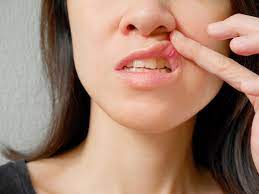Canker sores are a common nuisance that will affect most people at some point in their lives. Also known as aphthous ulcers or “mouth ulcers,” canker sores appear as oral lesions on your tongue, palate or the inside of your cheeks. As they only affect the interior of your mouth, your friends won’t be able to see them — but you’ll know they’re there. Shallow and circular in appearance, these small, painful sores appear white or gray at the center with a surrounding red border, and they are extremely sensitive to the touch.
Women are more likely than men to experience canker sores, but the first symptoms don’t usually occur until after the age of 10.
For most of us, mouth ulcers only occur occasionally, experiencing simple canker sores several times a year. These lesions are usually less than 1 cm in diameter, and will usually heal within 2 weeks. But others may find themselves a victim of complex canker sores, which are often larger in appearance, occur more frequently and take longer to heal.
A Sore Subject
No one quite knows how or why we get canker sores, although scientists have distinguished several factors that can trigger an outbreak. Stress, acidic foods and certain drugs are thought to cause a canker sore to flare up. Mouth irritations, such as biting the inside of your cheek or wearing dental braces, may cause you to experience more frequent outbursts as well. In some cases, a vitamin deficiency, problems with the immune system or gastrointestinal tract, or even hormonal changes can launch a canker sore into action!
Canker sores are more than a minor abrasion. They often cause mouth pain, ranging from mild discomfort to sharp, stinging sensations. You may know you’re getting a canker sore if you notice a tingling or burning feeling in the area of your mouth that’s affected. Once canker sores appear, they are vulnerable to outside elements. Sufferers of cankers sores have difficulty eating, drinking and even talking during an outbreak!
The good news is that unlike cold sores, canker sores are not caused by a virus and therefore are not contagious. While cold sores appear as blisters on the lips and surrounding areas of the face, canker sores only appear inside the mouth and aren’t noticeable.
Canker Sores: Treatment and Prevention
There’s no real cure for canker sores, and they often heal on their own. But if you’re experiencing discomfort during an outbreak, there are several over-the-counter and prescription remedies you can use to ease the discomfort and speed up healing. Certain mouthwashes and ointments may assist in decreasing the pain, but they only provide limited relief. Your best bet for battling canker sores is to avoid the possible causes, including limiting acidic foods and practicing excellent oral hygiene, which helps prevent irritation.
If you experience extreme pain, large mouth ulcers or several canker sores at once, you may want to get your condition checked out. Oral lesions that continuously reoccur or last more then three weeks should also warrant a professional opinion. A dentist can prescribe medications to control the pain and help you determine the possible causes. In extreme cases, a dentist may also test the area to rule out other diseases, such as oral cancer.

